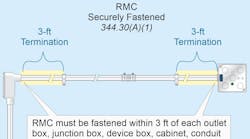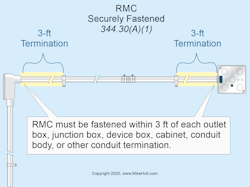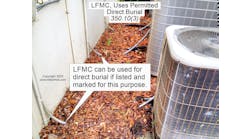Courtesy of www.MikeHolt.com
Q. What are the requirements for securing and supporting RMC?
See answer below.
A. The requirements for securing and supporting RMC are in Sec. 344.30.
RMC must be securely fastened in place and supported in accordance with (A) and (B).
(A) Securely Fastened. RMC must be secured in accordance with any of the following:
(1) Fastened within 3 ft of each outlet box, junction box, device box, cabinet, conduit body, or other conduit termination (Figure).
Author’s Comment: Fastening is required within 3 ft of terminations, not within 3 ft of each coupling.
(2) When structural members do not permit the raceway to be secured within 3 ft of a box or termination fitting, the raceway must be secured within 5 ft of the termination.
(3) Where approved, RMC is not required to be securely fastened within 3 ft of the service head for an above-the-roof termination of a mast.
(B) Supports.
(1) General. RMC must be supported at intervals not exceeding 10 ft.
(2) Straight Runs. Straight runs made with threaded couplings can be supported in accordance with the distances contained in Table 344.30(B)(2).
(3) Vertical Risers. Exposed vertical risers for fixed equipment can be supported at intervals not exceeding 20 ft if the conduit is made up with threaded couplings, firmly supported, securely fastened at the top and bottom of the riser, and if no other means of support is available.
(4) Horizontal Runs. Conduits installed horizontally in bored or punched holes in wood or metal framing members, or notches in wooden members are considered supported, but the raceway must be secured within 3 ft of termination.
Author’s Comment: RMC must be provided with expansion fittings where necessary to compensate for thermal expansion and contraction [300.7(B)]. The expansion characteristics for metal raceways are determined by multiplying the values from Table 352.44 by 0.20, and those for aluminum raceways are determined by multiplying the values from Table 352.44 by 0.40 [Sec. 300.7 Note].
These materials are provided to us by Mike Holt Enterprises in Leesburg, Fla. To view Code training materials offered by this company, visit www.mikeholt.com/code.





